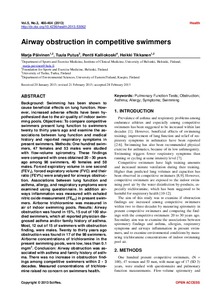Airway obstruction in competetive swimmers.
Putus T; Kalliokoski P; Tikkanen H; Päivinen M
https://urn.fi/URN:NBN:fi-fe2021042715394
Tiivistelmä
Background: Swimming has been shown to cause beneficial effects on lung function. However, increased adverse effects have been hypothesized due to the air quality of indoor swimming pools. Objectives: To compare competitive swimmers present lung function to swimmers twenty to thirty years ago and examine the associations between lung function and medical history and reported respiratory symptoms in present swimmers. Methods: One hundred swimmers, 47 females and 53 males were studied with flow-volume spirometry. These findings were compared with ones obtained 20 - 30 years ago among 98 swimmers, 40 females and 58 males. Forced expiratory volume in one second (FEV1), forced expiratory volume (FVC) and their ratio (FEV%) were analysed for airways obstruction. Associations between lung function and asthma, allergy, and respiratory symptoms were examined using questionnaire. In addition airways inflammation was measured with exhaled nitric oxide measurement (FENO) in present swimmers. Airborne trichloramine was measured in air of indoor swimming pools. Results: Airway obstruction was found in 15%, 15 out of 100 studied swimmers, which all reported physician diagnosed asthma and/or family history of asthma. Most, 12 out of 15 of swimmers with obstruction finding, were males. Twenty to thirty years ago obstruction was found in 17 of the 98 swimmers. Airborne concentrations of trichloramine in the present swimming pools, were low, less than 0.1 mg/m3. Conclusion: Airway obstruction was associated with asthma and family history of asthma. There was no increase in obstruction findings among competitive swimmers within 2 - 3 decades. Measured concentrations of trichloramine raised no concern on swimmers health.
Kokoelmat
- Rinnakkaistallenteet [19207]
